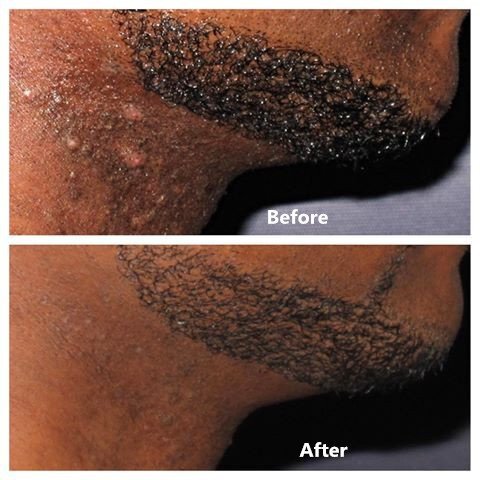








Are your razor bumps Painful?
Pseudofolliculitis barbae (PFB) is most common on the face, but it can also happen on other parts of the body where hair is shaved or plucked, especially areas where hair is curly and the skin is sensitive.
After a hair has been shaved, it begins to grow back. Curly hair tends to curl into the skin instead of straight out the follicle, leading to an inflammation reaction. PFB can make the skin look itchy and red, and in some cases, it can even look like pimples. These inflamed papules or pustules can form especially if the area becomes infected.
This is especially a problem for some men who have naturally coarse or tightly curling thick hair. Curly hair increases the likelihood of PFB by a factor of 50. If left untreated over time, this can cause keloid scarring in the beard area.
Pseudofolliculitis barbae can further be divided into two types of ingrown hairs: transfollicular and extrafollicular. The extrafollicular hair is a hair that has exited the follicle and reentered the skin. The transfollicular hair never exits the follicle, but because of its naturally curly nature curls back into the follicle causing fluid build-up and irritation.
PREVENTION
The most efficient prevention is to grow a beard. For men who are required to, or simply prefer to shave, studies show the optimal length to be about 0.5 mm to 1 mm to prevent the hair growing back into the skin. Using a beard trimmer at the lowest setting (0.5mm or 1mm) instead of shaving is an efficient alternative. The resulting faint stubble can be shaped using a standard electric razor on non-problematic areas (cheeks, lower neck).
For most cases, completely avoiding shaving for three to four weeks allows all lesions to subside, and most extrafollicular hairs will resolve themselves within at least ten days. Permanent removal of the hair follicle is the only definitive treatment for PFB.
Exfoliation with various tools such as brushes and loofahs also helps prevent bumps.
Some men use electric razors to control PFB. Those who use a razor should use a single blade or special wire-wrapped blade to avoid shaving too closely, with a new blade each shave. Shaving in the direction of hair growth every other day, rather than daily, may improve pseudofolliculitis barbae. If one must use a blade, softening the beard first with a hot, wet washcloth for five minutes or shave while showering in hot water can be helpful. Some use shaving powders (a kind of chemical depilatory) to avoid the irritation of using a blade. Barium sulfide-based depilatories are most efficient, but produce an unpleasant smell.
TREATMENT
We are able to help you heal your skin and scarring as you adapt your behavior to your new rules of your facial hair. The simplest treatment for you to control is to let the beard grow. Existing razor bumps can often be treated by removal of the ingrown hair. Extrafollicular hairs can usually be pulled gently from under the skin with tweezers. Using the fingernails to "burst" razor bumps can lead to infection and scarring, and should be avoided at all costs. Complete removal of the hair from its follicle is not recommended. Severe or transfollicular hairs may require removal by a dermatologist. We have a Men’s facial that will treat your existing bumps with a High frequency wand to zap all bacteria in the skin causing infection and pain.
If you are having a current severe breakout you may be required to book weekly facials for the first 4-6 weeks to treat your infected follicles with high frequency at regular intervals. These treatments will also prevent generalized scarring as well as keloid scarring. While drying out the bacteria and infection in your follicles and speeding the healing process.
Medications may also prescribed by a dermatologist in more severe cases to speed healing of the skin your esthetician will discuss your skin with you.
Clinical trials have shown glycolic acid-based peels to be an effective and well-tolerated therapy which resulted in significantly fewer PFB lesions on the face and neck. Salicylic acid peels are also effective. Retin-A is a potent treatment that helps even out any scarring after a few months. It is added as a nightly application of Retin-A cream 0.05–0.1% to the beard skin while beard is growing out. Tea tree oil, witch hazel, and hydrocortisone are also noted treatments and remedies for razor bumps.